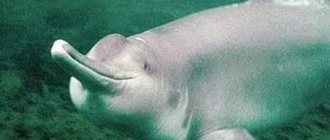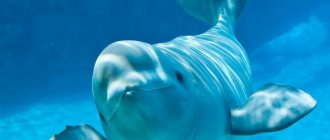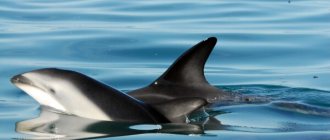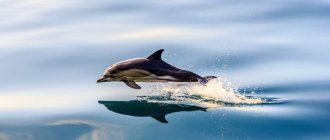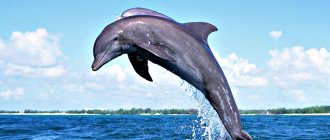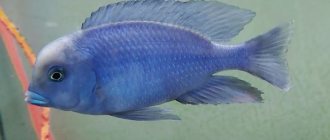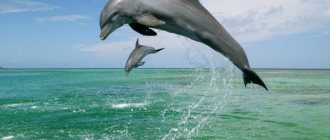Amazon river dolphin (also known as pink dolphin) is a freshwater animal. It is found in the Amazon and Orinoco rivers, as well as waterways located in Bolivia, Colombia and Peru. The river dolphin is smaller than other species of sea dolphins, and this species has excellent hearing. These dolphins must live in warm, shallow water areas because they have very little body fat. River dolphins suffer in captivity, and few aquariums are able to keep them alive.
Amazon river dolphins also tend to become more pink as they age, leading to the species becoming known as the "pink dolphin."
Species of Amazon River dolphins
There is considerable debate within the scientific community as to whether the Amazon river dolphin is actually one, two, or even three different species.
In 2014, Brazilian scientists published that the river dolphins in the Araguaia River are a unique species, the Araguaia river dolphin. Additionally, there has been considerable debate about whether the river dolphins living in Bolivia are a unique species.
As of 2022, the IUCN recognizes three subspecies: the Amazonian river dolphin, the Bolivian river dolphin, and the Orinoco river dolphin.
Myths and legends
Inia, or bouto (as the Amazonian dolphin is called in the local dialect), is quite popular among the Brazilian Indians. They do not kill it or use it for food, treating it with deep respect. And not only because the meat of the river dolphin is quite stringy and tough, there is not enough fat, and the skin is suitable only for making shields. The locals have legends and magical stories about this mammal, passed down from generation to generation. The image of Inia is interpreted as an evil sorceress who can lure young and inexperienced natives into her abyss in order to destroy them. According to legends, in this form, inia even appears on the streets, and many people over the centuries become captivated and follow the magician. And time after time, Inia hugs the chosen victims and disappears into the waves of the river with a cry of victory. Therefore, among the Amazon Indians, they will not specifically kill an Amazonian dolphin, unless by pure chance. But even then it is necessary to perform certain rituals in order to avoid troubles. And although dolphin fat is quite suitable for burning, for example, in primitive native lamps, no one will use such a light source, in order to avoid troubles that could befall the Indian.
Pink dolphin appearance and behavior
The pink river dolphin has that characteristic dolphin smile. They have rounded foreheads and long thin beaks.
While other species of river dolphins, such as the Gangetic river dolphin, are dimorphic, with females being larger than males, the opposite is true for Amazonian river dolphins. Males can grow to be approximately 50% larger than females and weigh over 400 pounds (180 kg).
The animal has conical teeth which they use to catch small fish and other prey. The river dolphin has a long nose that can reach 58 cm in length, which is about four times larger than the nose of ocean dolphins. River dolphins have a two-chambered stomach and breathe by emitting air through a blowhole.
Animals swim with great precision. Because river dolphins are extremely flexible, they can maneuver around rocks, tree trunks and other objects. They also have the ability to swim forward using one flipper while the other flipper paddles backward. This swimming method allows them to make sharp turns. River dolphins also like to swim upside down.
River dolphins have exceptionally large brains, and while dolphins are known to swim in groups, river dolphins tend to spend more time alone or among small groups of two to four dolphins. You may see large groups of them in food-rich areas, but this is less common among river dolphins.
The Amazon river dolphin does not have a dorsal fin. Instead, he sports a modified hump. The animal makes its way through rivers and flooded areas using strong flippers and a tail fluke. Compared to oceanic dolphins, river dolphins swim slowly. Their maximum speed is about 56 km/h. The reason for this is that their cervical vertebrae are not fused. This gives them greater flexibility, but it means they cannot swim as fast. River dolphins are able to turn their heads without moving their bodies.
Like their oceanic relatives, pink river dolphins are friendly and curious. They often interact with people. River dolphins have unique hearing adaptations that help them survive in the aquatic environment. Dolphins make sound from their throat, not from their outer ear to their inner ear. The animal's ear is also acoustically separated from its head. Separating these two parts of the body are the sinus pouches. This combination gives the animal enhanced directional hearing underwater. Dolphins use an organ called the melon to produce high-frequency clicks. This allows them to produce bio-sonar. They use it to navigate.
Dolphins rely on echolocation. This species uses echolocation so well that a river dolphin can survive even if it is blind. Echolocation allows an animal to determine the size and shape of any surrounding object or object. River dolphins have small eyes and poor vision. In addition, their eyes are located on the sides of their heads. This means that their vision has two separate views, rather than the direct view that humans see.
Researchers believe that some species of river dolphins are blind, while others simply have extremely poor eyesight. Many animals die due to accidental contact with nets and fishing boats.
Lifestyle
Inias , as a rule, live alone or in pairs (usually a female with a cub), rarely in groups of 3-6 individuals. Large flocks are observed in areas rich in food or during the breeding season. Inias are not territorial, they do not establish a social hierarchy (in captivity), however, they often show aggression towards each other, sometimes leading to death. They are active both during the day and at night. They swim slower than most dolphins: their usual speed is 1.5-3.2 km/h, maximum - 14-22 km/h, but they are very maneuverable. The hoarfrost dives shallowly; they remain under water for no more than 0.5-2 minutes, and when exhaling they release small fountains; sometimes they jump out of the water to a height of more than 1 meter.
In nature, inies are playful and quite curious. Like sea dolphins, they take care of wounded and stranded relatives. Inias are tamed well, but they are aggressive and difficult to train, so they are quite rare in oceanariums.
Why are Amazon River Dolphins pink?
One of the distinguishing characteristics of Amazon dolphins is that they often turn pink. Scientists are still investigating the reasons for this unique coloration, but several theories stand out.
- Fighting: While not aggressive with humans, Amazon pink river dolphins often fight each other and leave a significant amount of scar tissue. This scar tissue is thought to turn pink, which is the reason why older dolphins tend to have the most characteristic pink coloration.
- Camouflage: Amazonian pink river dolphins live in rivers along the Amazon rainforest, which are often flooded by incredible amounts of rain. This high level of precipitation causes the muddy river bottoms to take on a red-pink hue. Amazon pink river dolphins may have simply evolved to blend in better with their surroundings.
It's important to note that most Amazon river dolphins are born grayer, and males tend to become pinker as they age. Additionally, this pink coloration usually covers parts of their body, while areas of gray remain. There is a hypothesis that males with pinker coloration are better able to attract females.
Reproduction
The reproductive biology of the Amazonian dolphin is poorly understood. Inii are believed to be polygamous - males are often covered in bite marks and abrasions received during competition for a female. Inia's pregnancy lasts 11 months; labor lasts 4-5 hours. The birth of the only cub occurs in May - July, i.e., during the period when the water is at its highest. The length of a newborn dolphin reaches 75-80 cm, weight - 7 kg; the female pushes it to the surface for the first breath. Females with cubs remain in channels and on flooded plains when the water begins to subside (males return to the rivers earlier). This habitat has a number of advantages, including more food, lack of strong currents and predators, and a reduced risk of aggression from adult males. Females feed their cubs with milk for up to 1 year, but they often stay with their mother longer, up to 3 years. The interval between births is 15-36 months; Often lactating females are pregnant at the same time. Males and females reach sexual maturity by 5 years, with a body length of 2 m (males) and 1.6-1.7 m (females). The lifespan of ini in nature is unknown; in captivity, they usually live no more than 33 months, although individuals are known that lived up to 10-26 years.
Pink dolphin habitat and distribution
Amazon pink river dolphins live in freshwater areas, including lakes, huge rivers and small tributaries. Because the Amazon is fed by large areas of rain forest, it floods its banks for extended periods of time each year. During this period, Amazon pink river dolphins will spread across the vast inland seas that form in the floodplains.
You'll find them in Bolivia, Colombia, Ecuador, Brazil, Venezuela and Peru. The Amazonian pink river dolphin also lives in the Amazon and Orinoco and in the Araguaia River.
Nutrition
Inia feeds mainly on small fish, eating from 9 to 12 kg per day (about 2.5% of its own weight). Their diet is very diverse, including at least 43 species of fish from 19 families; prey sizes vary from 5 to 80 cm. Most of all, Amazonian dolphins love fish from the families of croakers, cichlids and piranhas. The structure of their teeth allows them to also eat Amazonian river turtles and crabs. Their diet is more varied during the wet season, when fish move to flooded areas and become more difficult to catch, and more selective during the dry season. Ini feed most actively between 6-9 a.m. and 3-4 p.m. They often hunt near the shore, in river mouths and under waterfalls, and also where two rivers merge and the turbidity of the water disorients the fish, making them easier to catch. Indians dig through the mud with their beak, taking food from the bottom; They can go into nets and steal fish from there. Sometimes they follow the boats, catching the fish they spook. Vision is well developed, although the main senses are hearing and touch. Echolocation is used to hunt and navigate underwater. They also make screams, high-pitched squeals, barks, whimpers, but not whistles.
What predators hunt Amazon river dolphins
Animals that prey on river dolphins include large snakes, jaguars and caimans. However, once the species has passed adolescence, it has few natural predators.
Human development and agriculture have had a major impact on the habitat of river dolphins. These activities impacted the ecology of the waterways. Human fishing also poses a threat to the species. Overfishing is a problem because it reduces the animal's food supply. Dolphins also get caught in the net.
Pollution is another threat to Amazon dolphins. Small-scale gold mining operations cause mercury pollution, and it makes its way to the dolphins through the food chain. River dolphins eat a lot of catfish, which live on the bottom of waterways where mercury tends to accumulate.
Amazon dolphins are endangered. The Brazilian Institute of Environment and Renewable Natural Resources has taken steps to protect dolphin species.
Features of the external structure
The appearance that pink dolphins have (the photos clearly demonstrate it) is typical for their representatives. The body length usually does not exceed 2.5 m, and the weight is about 200 kg. Only adult individuals have a characteristic body color. Lake inhabitants are usually darker than river inhabitants.
Pink dolphins are characterized by rather unusual sexual demorphism. The fact is that males are larger than females, which is not typical for most animals.
The body of dolphins is elongated, becoming thinner towards the tail. It ends with a beak, which is slightly curved downwards and covered with bristles. The number of teeth is about 120. They are differentiated and perform the functions of capturing, holding and chewing food. The cornea of small eyes is yellow in color. This device provides protection from bright light. The head of pink dolphins is movable and can be rotated 90 degrees. The single caudal and paired pelvic fins act as a rudder. But the dorsal one is missing. It is replaced by a small gentle hump.
Meaning in nature
Representatives of this species do not have any special commercial significance. In ancient times, their fat was used to fill lamps, and also as a medicine against attacks of asthma and rheumatism. Amulets for rituals are made from individual parts of the body.
But for fishermen, the presence of ini is a good sign. It means the presence of a large number of fish. In addition, pink dolphins drive away dangerous piranhas, making many places in rivers safer.
Due to the fact that pink dolphins often tear fishing nets and eat the intended catch, they have long been subject to destruction. Now these actions are prohibited, and many species are listed in the Red Book.
Pink dolphins are amazing representatives of the animal world, many of whose life secrets have yet to be discovered by humanity.
Pink miracle
In the United States, in the southwest of Louisiana, the salt lake Kalsasue is located.
In 2009, the captain of a local shipping company, Eric Rui, discovered and photographed a rare pink bottlenose dolphin in the waters of the lake. Apparently, this is the only cetacean in the world with a color so rare in nature. According to Captain Rui, the unique animal always appears on the surface in the company of four other relatives, one of which, apparently, is its mother, who does not want to let go of her offspring. The unusual dolphin is quite socialized. Its behavior is no different from the behavior of other animals of this species. It is only noticed that it appears less often and remains on the surface somewhat longer than other individuals. According to scientists, the dolphin is quite healthy, and its unusual color is not at all a consequence of an unfavorable environmental situation or harmful solar radiation. This unique animal looks at the world with red eyes, which indicates albinism.
Albinism is a fairly rare genetic trait characterized by the congenital absence of melanin, the substance that determines the color of the eyes, skin and hair.
So, the unique pink dolphin, according to experts, is an albino, although it is completely unclear how he inherited such a rare genetic quality.

